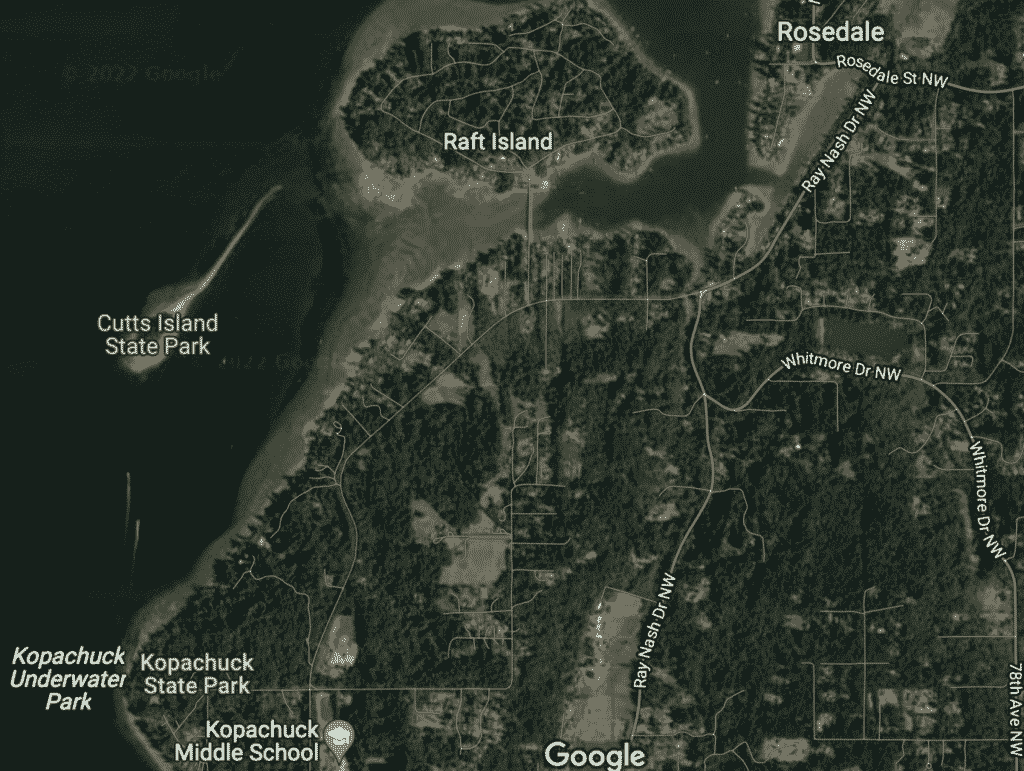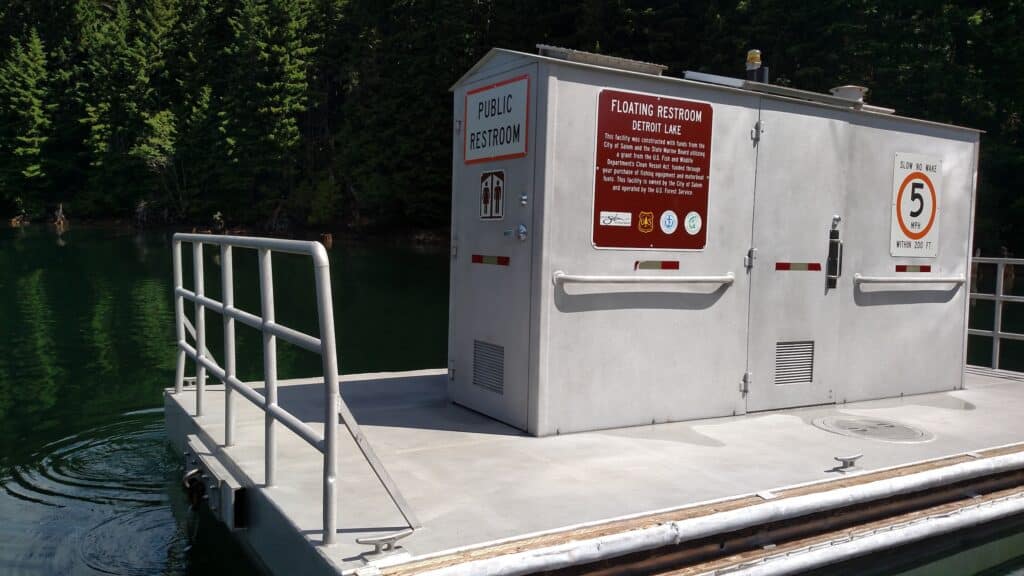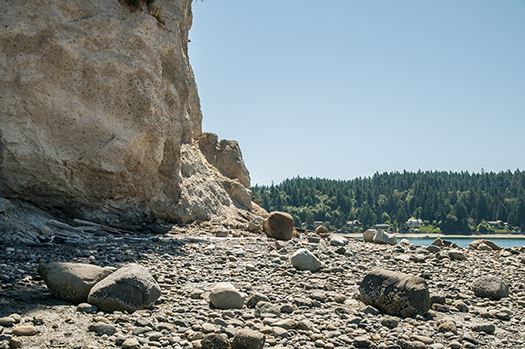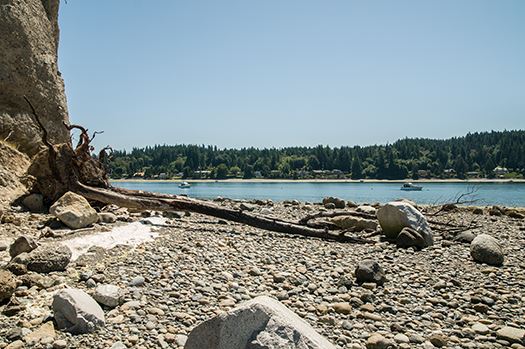Community Environment Government
Cutts Island chosen for first Puget Sound floating toilet
Paddlers who make the popular, half-mile trip from Kopachuck State Park to Cutts Island might discover a long sandy spit dotted with lounging seals. What they won’t find are restrooms.
Community Sponsor
Community stories are made possible in part by Peninsula Light Co, a proud sponsor of Gig Harbor Now.
The 2-acre day-use area is primitive, lacking power, water, garbage and sanitary service. What visitors pack in, they are asked to pack back out, including human waste.
The Cutts Island web page recommends that they carry and use human waste disposal bags in which excrement is treated and can be thrown away later. Seeking privacy on the cliffed clay butte, however, can result in an encounter with the isle’s notorious poison oak.

Cutts Island lies a half mile away from Kopachuck State park and is a popular destination of paddlers.
Washington State Parks hopes to obviate such adventurous nature calls by anchoring the Puget Sound’s first floating toilet offshore. The department announced in April that it will receive a $300,000 federal grant for the project.
If the floating toilet is like the 25 already in use in Oregon, boaters will glide alongside a 24-by-11.5-foot aluminum barge, tie up and step aboard. They can choose choose a toilet room at one end or the other, do their business in a stainless steel bowl or urinal, and flush.
Yes, flush. These are not floating port-a-potties.
Not just Sanikans on a float
One push of a button pumps a half gallon of fresh water from a 1,000-gallon tank through the toilet, swooshing the waste into a 1,000-gallon sewage storage tank. When the holding tank is full, the floating head is towed to shore to be pumped out or emptied in place by a vessel.
Not all Cutts visitors remove their waste, creating a perpetual garbage and human waste problem. This makes what is commonly known as Deadman’s Island a prime candidate for the state’s first floating saltwater restroom. (There is one on the Columbia River in Eastern Washington).

Oregon has 25 floating restrooms like this one on water bodies across the state. There are flushable toilets in rooms at each end.
“It’s a high-use area where there have been problems with defecation on the island,” said Rob Sendak, boating programs manager with the Washington State Parks and Recreation Commission. “That was recognized. We know that because folks go out there and clean it up.”
Pierce County’s willingness to help maintain the station after it is installed also weighed in the siting.
“It takes partners to do this and Pierce County jumping in as a partner is one of the reasons why it works (at Cutts),” Sendak said. “Also, the need was recognized that this would be a great place to not necessarily test this model, but I feel like that’s kind of what’s happening here.”
Grants devoted to pumpout and dump stations
State Parks’ Washington Clean Vessel Act Grant Program passes funding from the U.S. Fish and Wildlife Service through to support sewage disposal systems and outreach programs that inform boaters about the location of pumpout and dump stations. Grant recipients — state and local jurisdictions, marinas, tribes and nonprofits — typically must chip in a 25 percent match.
In Cutts’ case, State Parks passed the funds through to itself.
Other entities receiving part of the more than $700,000 in grants announced in April to purchase, operate and maintain dockside pumpouts included the ports of Port Townsend, Bremerton, Poulsbo and Kingston, West Sound and Tyee marinas, and the city of Chelan.
Cutts Island so far is the only floating restroom site. The new projects will help recreational boaters comply with the Puget Sound No Discharge Zone Law that has been in effect since 2018. Within the zone, boats can’t release sewage, whether treated or not.
“The Clean Vessel Act Program believes there is potential and a need for a handful of these (floating toilets) in the Puget Sound,” Sendak said, “whether it is State Parks partnering with the CVA or another jurisdiction that might want to play into this.”
The target date to build, permit and install the Cutts Island facility is the opening of the 2024 boating season. It would probably be available annually from May to September.
Oregon, California already have a bunch
Oregon and California already have established floating restroom programs with 25 and 40 heads, respectively. Oregon’s has existed without incident for at least 20 years, according to Oregon State Parks spokeswoman Ashley Massey. The problem has been trying to keep up with demand, whether adding new locations or emptying the waste.
“We’ve had tremendous success,” Massey said. “They’re highly valued by boaters and also the paddling community. They see these things out on the water and it’s, ‘Oh my gosh, a restroom.’ They don’t have to paddle all the way in. They can stay out on the water longer. That’s a huge perk.
“There’s a demand for them. If we could have them on every water body, we would. They do work. If anything, we’ve got several locations in key areas and they get full very quickly, so oftentimes we hear boaters say, ‘The restroom needs to be pumped out.’ Demand is high and they are well used and we have protected the water quality.”
The floating toilets are built to last a long time. They’re made of 90 percent recyclable materials, don’t harm the environment and are discreet.
“There’s a lot more to it in getting started, but once they’re in place and funded it’s a well-oiled machine,” Massey said. “We do need willing partners to make sure they’re well maintained and in in good operating condition.”
The CVA Grant Program also pays for operation and maintenance of more than 100 pumpout and dump station facilities across the state.
There are three pumpout stations locally, all in Gig Harbor proper — at Allabella’s Landing ($1 coin operated), Jerisich City Dock (free) and Maritime Pier (free).



